The answers to all your questions about Cyanotypes

The basics of the Cyanotype technique:
What is Cyanotype?
A cyanotype is a photographic printing technique and one of the oldest processes in the history of photography. The results can easily be recognized by their intense cyan-blue color, which is created through its exposure to sunlight. The process of cyanotype was discovered in 1842 by the English scientist John Herschel in order to reproduce notes and diagrams. Anna Atkins, a British botanist and photographer, first used the technique to document the beautiful shapes of her local seaweed varieties and is considered to be the first woman photographer. Her book famous book ‘Photographs of British Algae: Cyanotype Impressions’, was the first book to be photographically printed and illustrated. The technique has been widely used by artists and photographers, but also engineers, as a way to create affordable copies of technical drawings. To this day, we use the term “blueprint” to mean a technical drawing, for example for the floor plan of a house.

How does the Cyanotype technique work?
To create beautiful cyanotypes, you need a mixture of two different solutions (A + B). The necessary chemicals come in powder form. As a first step, you’ll need to add water to each bottle, to create a solution. Shake the bottles very well to make sure all the chemicals are dissolved. Once you mix the A and B liquids together, they will become sensitive to UV light. Apply an even coat of this mix to your surface (paper, textile or even wood) and let it dry fully in the dark.
Next, think of your layout and composition. You can play with different objects (plants, flowers or flat objects will work well) and place them directly on your coated surface. To keep them in place, it’s helpful to weigh them down with a sheet of glass. When you are satisfied with your composition, you can expose it to the sun. The necessary exposure time will vary depending on the weather conditions, the height of the sun in the sky, and the type of objects you are exposing. In the sunlight, the color of the emulsion will slowly shift from a yellow-green to a bronze-gray color. You can begin with an exposure time of 10 min, and start adjusting from there.
After exposure, rinse your paper in a tray, under running water. Be careful not to hit your print directly with a strong jet of water, as it might damage the fragile paper.
This is when the magic happens! The area of the image that was exposed to UV light will take on the cyan blue color, and the parts of the paper that were protected from the light will rinse out.
The blue color intensifies as it dries and further oxidizes in contact with the air. You’ll get the darkest color after about 24hrs. You can also speed this up by using a couple of drops of hydrogen peroxide in your last rinsing water.
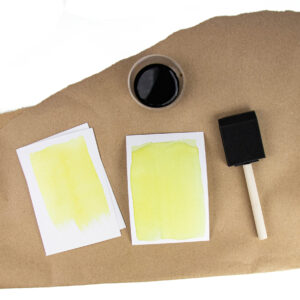
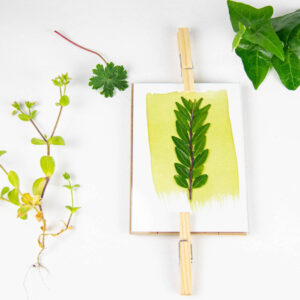
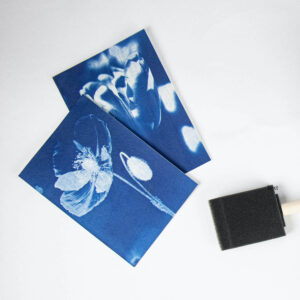
Are Cyanotype chemicals toxic?
The chemicals required to make cyanotypes are (A) potassium ferricyanide and (B) ferric ammonium citrate. These two chemicals are presented in the form of a powder that is mixed with water, to become the cyanotypes sensitizer. While neither is highly toxic, you should avoid breathing the powders in. Always add water to your cyanotype powder (inside the blue bottles) and not the other way around. This way you’ll avoid having the powder dispersing in the air.
The cyanotype technique does not present any significant health risk. However, common sense applies. Do not ingest or inhale the chemicals, and wear gloves when handling the solutions.
Here are the Safety Data Sheets for the active chemicals: (A) potassium ferricyanide and (B) ferric ammonium citrate.
How long do cyanotype chemicals last?
In powder form, each component (A and B) will last several years. Once mixed with water, the solutions can be kept for about a year, in their separate bottles. It’s possible that mold starts to form in the liquid. If this is the case, you can filter the liquid with a coffee filter and still use it.
Once you mix the 2 components A+B together, you should use the emulsion immediately, so only mix what you can use right away.
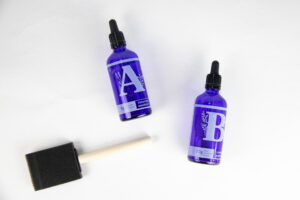
Can children use the cyanotype kit – is the cyanotype kit suitable for children?
The Botanopia Cyanotype Kit has not been designed for children and has also not been tested for children. However, it can still be a very fun activity to do together with children. Once an adult has prepared the solutions and coated the paper, supervised children can continue with the next steps of the process and create their own artwork in the sun. Let them play around with different plants, leaves and flowers
Exposure and light
Can you use artificial light for cyanotype?
The cyanotype emulsion reacts only to Ultraviolet light. Sunlight contains UV light, but if you’d like to make cyanotypes without sunlight, you can use artificial UV light for exposure. You can often find inexpensive second-hand sun-tanning lamps as your source of UV light. Small desktop models meant for tanning your face are a good choice to get you started.
Can you make cyanotypes in winter?
You don’t need a hot summer day to make cyanotypes. Even on a cloudy winter day you can expose your cyanotype prints with a few adjustments. In winter, there is less amount of sunlight available. The best time to work is around 12 noon, when the sun it at its highest point in the sky. You will need to increase the exposure time during the winter months. For example, a print that would take 5 min of exposure on a sunny summer day, might need 20 min of exposure on a cloudy winter day. Make sure to protect your work from any raindrops falling on the surface during the exposing process.
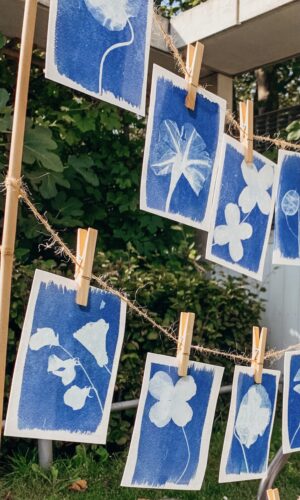
Can you make cyanotypes without sun?
Yes, you can make cyanotypes without sunlight, as long as you have another source of UltraViolet (UV) light. UV lights are found in sun-tanning lamps for example. You will need to test the correct exposure time for your specific lamp.
Can you make cyanotypes indoors?
The glass on your home’s windows may block some of the UV rays available in sunlight. While it’s not impossible, you’ll get better and faster results exposing your prints directly outside. Alternatively, you can also use an artificial source of UV light if you want to expose your cyanotypes without sunlight.
Can you make cyanotypes on a cloudy day?
Yes, cyanotypes work on cloudy days and you can definitely expose them, it will just take a bit longer. For example, a print that would need 5 min of exposure on a sunny day, might need 20 min of exposure on a cloudy day. If it’s also a little rainy, make sure you protect your prints from potential raindrops…
How long should you leave cyanotypes in the sun?
The exposure time can vary depending on a lot of different factors, such as how sunny it is, the time of the year (winter/summer), and also the type of plants that you want to expose. For example, if you’d like to achieve beautiful transparency effects on thin petals, like a poppy flower, you’ll need extra exposure time. Too long, and the thin petals will completely disappear. So it’s all about experimenting and adjusting, based on your own situation.
Paper, fabric and other materials
What is the best paper for cyanotypes?
For best results, you need paper that can handle getting wet and drying again. You need to rinse your cyanotype extensively under water, so your paper will need to survive a long bath. Paper made for watercolors is always a good choice. Traditionally, premium watercolor papers are made of cotton (also called rag paper). For all papers, we recommend a thicker stock, at least 200gsm. Avoid papers that have a coating that will prevent your emulsion from absorbing into the fibers. You can also experiment with different colors of paper that will complement the blue tint of your print.
Can you make cyanotypes on wood?
Yes, absolutely. Paper is made of cellulose, most often from wood pulp. So wood can act quite in the same way as paper when used in combination with the cyanotype technique. It can be a bit hit-and-miss though, depending on the exact type of wood you’re using, there are so many essences of trees. So you’ll have to experiment. In general, solid wood tends to give better results than engineered types such as veneer or plywood.
Can you make cyanotypes on fabric?
Yes, the cyanotype technique also works well on textiles made from natural fibres. For example; cotton, linen, wool, silk, hemp, bamboo but also fabrics derived from wood pulp such as viscose. Make sure to wash your fabric thoroughly first to remove any traces of starch or other stiffeners often used in the production process.
Are cyanotypes made on fabric washable?
Cyanotypes are quite sensitive to detergents and soaps. If you make cyanotypes on textiles, they won’t be very washable. You can attempt to carefully hand wash your fabric, but always test a small corner first. Be sure to use a soap or detergent that does not contain any phosphates, bleach, or sodium. Be prepared to experience some lightening of the blue color with every wash, no matter how careful you are.
Can you iron cyanotype-printed fabric?
Yes, ironing will not be an issue at all, just make sure to choose a heat setting appropriate for the type of fabric you used.
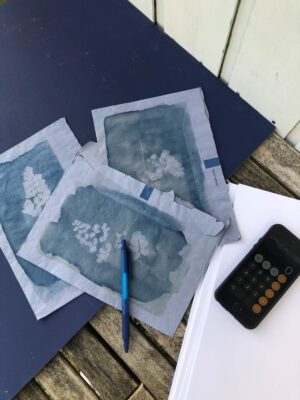
Preservation and changes over time
Will my cyanotypes fade – how long do cyanotypes last?
Cyanotypes are not completely UV-resistant and can indeed fade a little if they are constantly exposed to direct sunlight. But if kept under the right conditions, they can last decades. Choose a room for your print with normal daylight and no direct UV-light impact, and the Cyanotype should be fine
How do you preserve Cyanotypes?
To preserve your Cyanotype in the best conditions, don’t place them in direct sunlight. They are not entirely resistant to the impact of UV-light and can therefore fade. To further protect your print, you can frame the cyanotypes with UV-resistant glass and store them in a dry, cool environment with plenty of oxygen. If fading occurs, you can bathe your Cyanotype in hydrogen peroxide to restore its original color. The blue colors will also regenerate by placing the print in a dark space, such as a drawer or a cupboard, as long as enough oxygen is present.
Where to buy cyanotype chemicals and supplies?
If you want to embark on the cyanotype adventure, a complete kit is the best way to get started. The Botanopia Cyanotype Kit includes all the materials and tools to create your first blueprint, including detailed instructions and a tutorial. Once you feel comfortable with the included paper sheets, you can try it on your own paper or textiles like cotton or silk.
